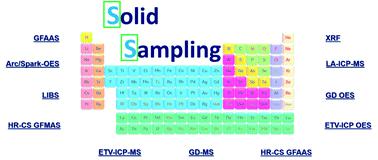当前位置:
X-MOL 学术
›
J. Anal. At. Spectrom.
›
论文详情
Our official English website, www.x-mol.net, welcomes your
feedback! (Note: you will need to create a separate account there.)
Solid sampling: advantages and challenges for chemical element determination—a critical review
Journal of Analytical Atomic Spectrometry ( IF 3.1 ) Pub Date : 2019-10-24 , DOI: 10.1039/c9ja00306a Raquel C. Machado 1, 2, 3, 4, 5 , Daniel F. Andrade 1, 2, 3, 4, 5 , Diego V. Babos 1, 2, 3, 4, 5 , Jeyne P. Castro 1, 2, 3, 4, 5 , Vinicius C. Costa 1, 2, 3, 4, 5 , Marco Aurelio Sperança 1, 2, 3, 4, 5 , José Augusto Garcia 1, 2, 3, 4, 5 , Raimundo R. Gamela 1, 2, 3, 4, 5 , Edenir R. Pereira-Filho 1, 2, 3, 4, 5
Journal of Analytical Atomic Spectrometry ( IF 3.1 ) Pub Date : 2019-10-24 , DOI: 10.1039/c9ja00306a Raquel C. Machado 1, 2, 3, 4, 5 , Daniel F. Andrade 1, 2, 3, 4, 5 , Diego V. Babos 1, 2, 3, 4, 5 , Jeyne P. Castro 1, 2, 3, 4, 5 , Vinicius C. Costa 1, 2, 3, 4, 5 , Marco Aurelio Sperança 1, 2, 3, 4, 5 , José Augusto Garcia 1, 2, 3, 4, 5 , Raimundo R. Gamela 1, 2, 3, 4, 5 , Edenir R. Pereira-Filho 1, 2, 3, 4, 5
Affiliation

|
In recent decades, direct solid sample analysis has been reported in the literature as an alternative to traditional methods of sample preparation, becoming well established in the atomic spectrometry field. Therefore, this review discusses recent advances in different techniques such as flame atomic absorption spectrometry, graphite furnace atomic absorption spectrometry, high-resolution continuum source graphite furnace atomic absorption spectrometry, electrothermal vaporization, laser ablation, laser-induced breakdown spectroscopy, X-ray fluorescence spectrometry, glow discharge optical emission and mass spectrometry and arc/spark optical emission spectrometry, which are the most commonly used techniques for solid sample analysis. New possibilities such as nonmetal detection through molecular emission or absorption signals, speciation analysis, portable instrumentation for in situ analysis, and surface elemental mapping for obtaining chemical imaging will be discussed. Aspects associated with advantages and limitations are presented, relating the main instrumental advances to the expansion of the methods developed in this subject, pointing out the potential ability to overcome spectral interference and matrix effects through the development of calibration strategies to achieve the success of solid sampling in several application areas.
中文翻译:

固体采样:化学元素测定的优势和挑战-严格审查
近几十年来,已有文献报道直接固体样品分析作为传统样品制备方法的一种替代方法,在原子光谱学领域已得到公认。因此,本综述讨论了不同技术的最新进展,例如火焰原子吸收光谱法,石墨炉原子吸收光谱法,高分辨率连续谱源石墨炉原子吸收光谱法,电热汽化,激光烧蚀,激光诱导击穿光谱,X射线荧光光谱法,辉光放电光发射光谱法和质谱法以及电弧/火花光发射光谱法,这是固体样品分析中最常用的技术。新的可能性,例如通过分子发射或吸收信号进行非金属检测,形态分析,将进行原位分析,并讨论用于获得化学成像的表面元素映射。介绍了与优点和局限性相关的方面,将主要的仪器进展与本主题中开发的方法的扩展相关联,指出了通过开发校准策略以成功实现固体采样来克服光谱干扰和基质效应的潜在能力在几个应用领域。
更新日期:2019-10-24
中文翻译:

固体采样:化学元素测定的优势和挑战-严格审查
近几十年来,已有文献报道直接固体样品分析作为传统样品制备方法的一种替代方法,在原子光谱学领域已得到公认。因此,本综述讨论了不同技术的最新进展,例如火焰原子吸收光谱法,石墨炉原子吸收光谱法,高分辨率连续谱源石墨炉原子吸收光谱法,电热汽化,激光烧蚀,激光诱导击穿光谱,X射线荧光光谱法,辉光放电光发射光谱法和质谱法以及电弧/火花光发射光谱法,这是固体样品分析中最常用的技术。新的可能性,例如通过分子发射或吸收信号进行非金属检测,形态分析,将进行原位分析,并讨论用于获得化学成像的表面元素映射。介绍了与优点和局限性相关的方面,将主要的仪器进展与本主题中开发的方法的扩展相关联,指出了通过开发校准策略以成功实现固体采样来克服光谱干扰和基质效应的潜在能力在几个应用领域。











































 京公网安备 11010802027423号
京公网安备 11010802027423号